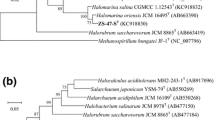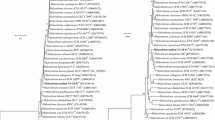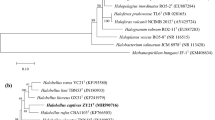Abstract
Halophilic archaeal strain YC89T was isolated from Yuncheng salt lake in Shanxi, China. Cells from strain YC89T were short rods, lysed in distilled water, stained Gram-negative and formed red-pigmented colonies on agar plate. Strain YC89T was able to grow at 25–50 °C (optimum 37 °C), at 1.4–4.8 M NaCl (optimum 2.6–3.1 M), at 0–1.0 M MgCl2 (optimum 0.3 M) and at pH 6.0–9.5 (optimum pH 7.5). The major polar lipids are phosphatidylglycerol, phosphatidylglycerol phosphate methyl ester, sulfated mannosyl glucosyl diether and two unknown glycolipids. 16S rRNA gene analysis revealed that strain YC89T was phylogenetically related to Halorientalis persicus D108T (95.6 % nucleotide identity) and H. regularis TNN28T (95.3 % nucleotide identity). The rpoB′ gene similarities between strain YC89T and H. persicus IBRC-M 10043T and H. regularis TNN28T were 88.1 and 88.0 %, respectively. The DNA G+C content of strain YC89T was determined to be 61.3 mol%. The phenotypic, chemotaxonomic and phylogenetic properties suggested that strain YC89T (=CGMCC 1.12125T = JCM 18366T) represents a new species of Halorientalis, for which the name H. brevis sp. nov. is proposed.

Similar content being viewed by others
References
Amoozegar MA, Makhdoumi-Kakhki A, Mehrshad M, Fazeli SAS, Spröer C, Ventosa A (2014) Halorientalis persicus sp. nov., an extremely halophilic archaeon isolated from a salt lake and emended description of the genus Halorientalis. Int J Syst Evol Microbiol 64:940–944
Cui H-L, Zhou P-J, Oren A, Liu S-J (2009) Intraspecific polymorphism of 16S rRNA genes in two halophilic archaeal genera, Haloarcula and Halomicrobium. Extremophiles 13:31–37
Cui H-L, Gao X, Yang X, Xu X-W (2010) Halorussus rarus gen. nov., sp. nov., a new member of the family Halobacteriaceae isolated from a marine solar saltern. Extremophiles 14:493–499
Cui H-L, Yang X, Gao X, Xu X-W (2011) Halobellus clavatus gen. nov., sp. nov. and Halorientalis regularis gen. nov., sp. nov., two new members of the family Halobacteriaceae. Int J Syst Evol Microbiol 61:2682–2689
Cui H-L, Yang X, Mou Y-Z (2011) Salinarchaeum laminariae gen. nov., sp. nov.: a new member of the family Halobacteriaceae isolated from salted brown alga Laminaria. Extremophiles 15:625–631
Kim M, Oh H-S, Park S-C, Chun J (2014) Towards a taxonomic coherence between average nucleotide identity and 16S rRNA gene sequence similarity for species demarcation of prokaryotes. Int J Syst Evol Microbiol 64:346–351
Liu Q, Ren M, Zhang L-L (2015) Natribaculum breve gen. nov., sp. nov. and Natribaculum longum sp. nov., halophilic archaea isolated from saline soil. Int J Syst Evol Microbiol 65:604–608
Marmur J, Doty P (1962) Determination of the base composition of deoxyribonucleic acid from its thermal denaturation temperature. J Mol Biol 5:109–118
Meier-Kolthoff JP, Göker M, Spröer C, Klenk H-P (2013) When should a DDH experiment be mandatory in microbial taxonomy? Arch Microbiol 195:413–418
Minegishi H, Kamekura M, Itoh T, Echigo A, Usami R, Hashimoto T (2010) Further refinement of Halobacteriaceae phylogeny based on the full-length RNA polymerase subunit B′ (rpoB′) gene. Int J Syst Evol Microbiol 60:2398–2408
Oren A, Ventosa A, Grant WD (1997) Proposed minimal standards for description of new taxa in the order Halobacteriales. Int J Syst Bacteriol 47:233–238
Oren A, Arahal DR, Ventosa A (2009) Emended descriptions of genera of the family Halobacteriaceae. Int J Syst Evol Microbiol 59:637–642
Oren A (2012) Taxonomy of the family Halobacteriaceae: a paradigm for changing concepts in prokaryote systematics. Int J Syst Evol Microbiol 62:263–271
Oren A (2014) Taxonomy of halophilic Archaea: current status and future challenges. Extremophiles 18:825–834
Xu W-D, Zhang W-J, Han D, Cui H-L, Yang K (2014) Halorussus ruber sp. nov., isolated from an inland salt lake of China. Arch Microbiol 197:91–95
Yuan P-P, Zhang W-J, Han D, Cui H-L (2015) Haloarchaeobius salinus sp. nov., isolated from an inland salt lake of China. Int J Syst Evol Microbiol 62:910–914
Tamura K, Peterson D, Peterson N, Stecher G, Nei M, Kumar S (2011) MEGA5: molecular evolutionary genetics analysis using maximum likelihood, evolutionary distance, and maximum parsimony methods. Mol Biol Evol 28:2731–2739
Acknowledgments
This work was supported by the National Natural Science Foundation of China (No. 31370054), the 11th “Six Talents Peak” Project of Jiangsu Province (No. 2014-SWYY-021), the Qinglan Project of Jiangsu Province and a project funded by the Priority Academic Program Development of Jiangsu Higher Education Institutions (PAPD). We are grateful to Dr. M. A. Amoozegar for kindly providing strain Halorientalis persicus IBRC-M 10043T.
Author information
Authors and Affiliations
Corresponding author
Additional information
The GenBank/EMBL/DDBJ accession numbers for the 16S rRNA gene and rpoB ′ gene sequences of strain YC89T are JQ237120 and KJ913076, respectively.
Phase-contrast micrograph of strain YC89T, thin-layer chromatograms of strain YC89T and related members, neighbour-joining phylogenetic tree reconstructions based on 16S rRNA gene and rpoB′ gene sequences showing the relationships between strain YC89T and related members within the family Halobacteriaceae are available as supplementary materials.
Electronic supplementary material
Below is the link to the electronic supplementary material.
Rights and permissions
About this article
Cite this article
Yuan, PP., Yin, S., Han, D. et al. Halorientalis brevis sp. nov., Isolated from an Inland Salt Lake of China. Curr Microbiol 71, 382–386 (2015). https://doi.org/10.1007/s00284-015-0861-3
Received:
Accepted:
Published:
Issue Date:
DOI: https://doi.org/10.1007/s00284-015-0861-3




